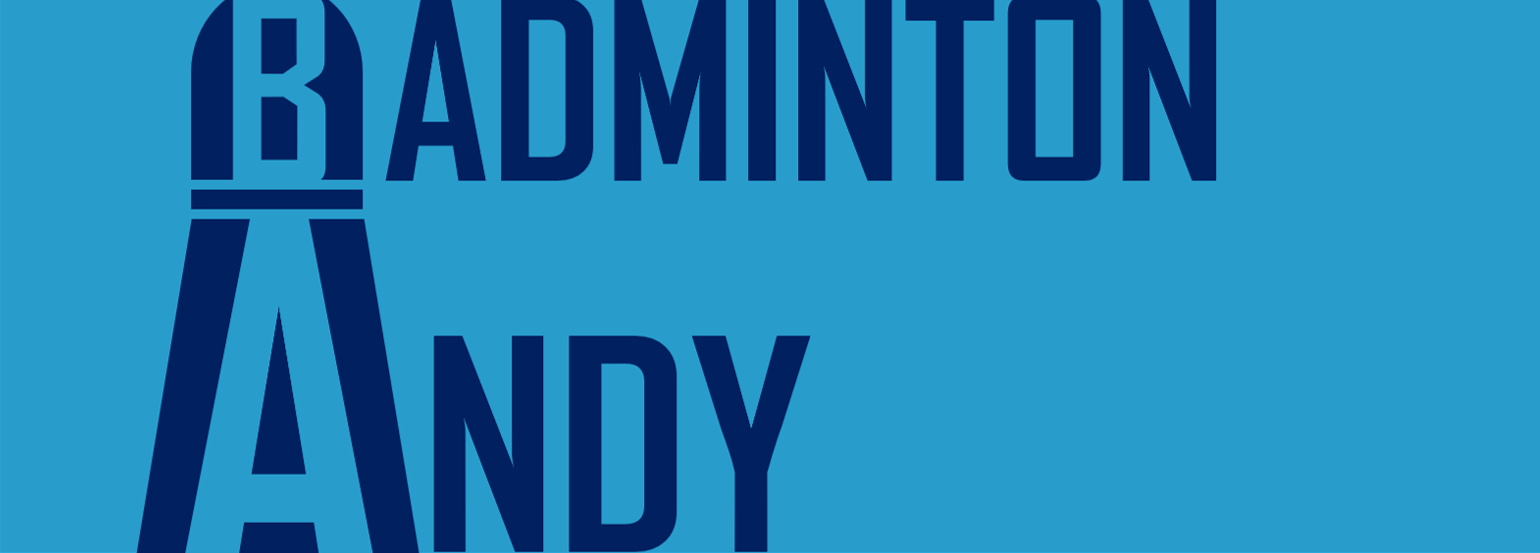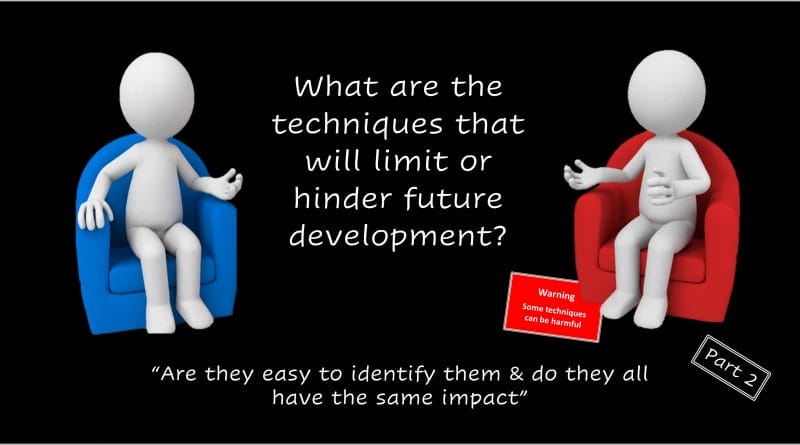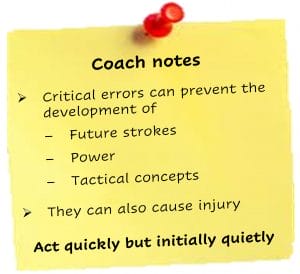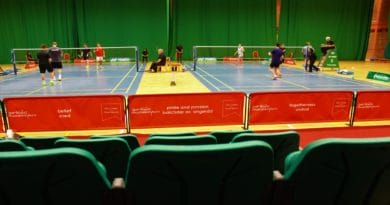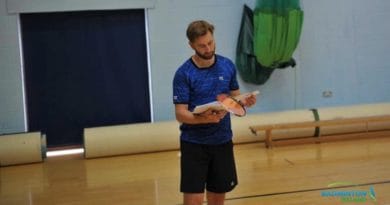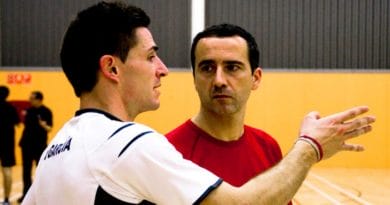Error prevention rather than error correction : Part 2
Could you create a list of the technical faults that you wished never developed in novice players?
Those issues that you know will limit future development of young badminton players
What criteria do you use to help with their identification?
I’m sure that you already see many of the issues
However, some are more difficult to identify and not all as critical as each other
– – – – – – – – – – – – – – – – – –
Have you read Part 1
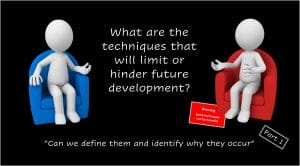 If you haven’t then click this image and read about how to define the technical limitations/ errors and why they may occur in novice players.
If you haven’t then click this image and read about how to define the technical limitations/ errors and why they may occur in novice players.
I am not suggesting that all players need to fit a perfect model of badminton technique, I’m sure that a ‘perfect model’ doesn’t even exist. There must be a wide bandwidth of techniques that can be used to play our game. If you look at players in high-level tournaments you will easily see a range of subtle differences in technique.
However, I’m sure that we all with players who are limited by their techniques. Some develop in players who have no role models or guidance, but others unfortunately also appear with players who receive regular coaching.
– – – – – – – – – – – – – – – – – –
Why it’s important to recognise and identify technical faults
Identifying Faults – questions to ask
Classification of errors : 3 types
Recognition difficulty and Impact assessment
What’s next
Your Challenge
– – – – – – – – – – – – – – – –
1. Why it’s important to recognise & identify technical faults
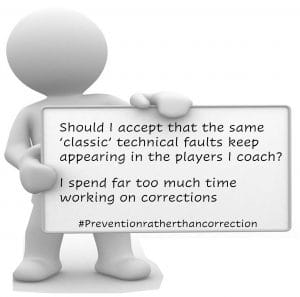 What are the critical badminton technique errors that every beginner player needs to avoid? Or, if you prefer, what are the technical aspects that limit future development. These should be one of the main concerns for coaches.
What are the critical badminton technique errors that every beginner player needs to avoid? Or, if you prefer, what are the technical aspects that limit future development. These should be one of the main concerns for coaches.
The issue of perennial ‘critical’ technical faults is not new. The same faults exist today as they did over 30 years ago, despite the evolution of coach education and the National Governing body award structures. I see no effective strategies to try and reduce or prevent the appearance of many ‘critical’ technical errors.
Many coaches spend an inappropriate proportion of their time working on the correction of errors (with their own players) rather than the progression of those skills. You may believe this still to be ‘coaching’ and part of the coach’s role. However, don’t you wish that these persistent problems/errors could be prevented by the setting of effective practices and tasks that reduce the likelihood of them appearing.
In order to fully develop and progress a skill, the incorrect or inappropriate elements of the skill must be eliminated. The development of skill into more refined or complex skills can then be a simpler progression with the time spent in error correction.
A player’s first coach will often be the most significant in both technical and psychological aspects
This first coach is faced with the problems of ….
- how to identify what techniques are a ‘problem’ and could be future limiting
- what are the practices that will establish the foundations for the development of future robust and effective techniques
- is there a preferred technique order to develop and how does this correlate to badminton strokes (named strokes)
- if they were to start and effect a change in technique, where to start and what to do
Coaches of novice players are often the most influential
Everything you say and do will make a difference!
– – – – – – – – – – – – – – – –
2. Identifying Faults – questions to ask
When watching players and looking for potentially limiting techniques, the coach is faced with multiple problems. To my knowledge very few, if any, Coach Education courses prepare coaches for this identification and assessment process.
I am not suggesting that all players need to fit a perfect model of technique, I’m not sure that a ‘perfect model’ even exists. There is a wide bandwidth of techniques that can be used to play our game.
The techniques we need to consider are those that may limit a player’s future development.
Unfortunately often seen in players who learn the game without any reference to what good players look like or any helpful guidance.
In the next post, I will expand on each of the questions below and give some guidance on how to use the questions.
Coaches should ask themselves the following questions: –
- What do I see?
- What was the intended outcome?
- Was this achieved?
- How does what I see compare with the known model? (i.e. playing basics)
- Where do I start to effect a change?
 By comparing a player’s stroke or movement to the playing basics the coach is able to quickly determine if there is a problem.
By comparing a player’s stroke or movement to the playing basics the coach is able to quickly determine if there is a problem.
This does not just apply to novice players because as all players develop they are in need of an evaluation to improve or correct their present techniques.
It is essential that coaches spend time improving their skills in the art of identifying and correcting weaknesses.
However, what are the underpinning Playing Basics that coaches should be aware of? These are the essential techniques that hold true under examination. Click on this image to read more 🙂
– – – – – – – – – – – – – – – –
3. Classification of technique errors ( including the potentially limiting)
 Not all badminton technique errors that a coach observes (especially in novice players) are a reason for immediate coach intervention. Players are unable to perform techniques for many reasons. The coach must be able to sift through and identify the ‘critical features’ whilst looking at the performance in real time. It’s not an easy task!
Not all badminton technique errors that a coach observes (especially in novice players) are a reason for immediate coach intervention. Players are unable to perform techniques for many reasons. The coach must be able to sift through and identify the ‘critical features’ whilst looking at the performance in real time. It’s not an easy task!
For discussion, I would like to propose that there are 3 types of technical faults that are seen. Each can cause the rally to end or provide the opponent with a rally winning opportunity.
Type 1 : Developmental
Often the players are limited as they haven’t had sufficient time and appropriate practice to establish some form of effective technique pattern that can work within all the variations found in a game. The technique may look inappropriate, yet could be effective.
Coaches need to be skilful at deciding when to intervene and how to test or encourage a change through a practice design.
Type 2 : Subtle
Can be difficult to observe. Issues may only appear when the player has to perform under stressful situations near to their physical, technical limits.
A player’s current performance level may not be limited by these faults and they can often be seen performing to near correct technique when under most practice sessions. Coaches need to distinguish between development errors and these subtle errors. The long-term development effect may not initially be apparent to coaches.
Type 3 : Critical
Often easier to observe than Type 2 errors. ‘Critical’ inappropriate techniques are those components of an action that affect the overall performance of the skill in a fundamental manner. If a critical feature is not performed to the expected level it will result in an error, and this may occur immediately.
These include those that are technically inhibiting and immediately limit performance, even with novice players.
They often prevent the future development of more finite skills, power transfer and tactical development. They can also cause injury if left unchecked.
This post is concerned only with Type 2 and Type 3 inappropriate techniques, as both have an impact on long-term development
How do you decide that a technique error is an ‘acceptable’ part of development or requires immediate intervention?
– – – – – – – – – – – – – – – –
4. Recognition difficulty and Impact assessment
When I first started coaching I found that there was so much to see, almost too much to take in. People would point out players with technique issues, but I couldn’t always see what they were highlighting. What were those illusive badminton technique errors?
I also didn’t realise that not all techniques that looked strange or didn’t fit my coaching model, were ‘bad’ techniques and needed to be changed. Then there were also techniques that seemed ok but coaches who knew far more than me said that we needed to start to address them immediately.
Where did you develop your recognition skills and do you believe that some inappropriate techniques are more critical than others?
Recognition difficulty?
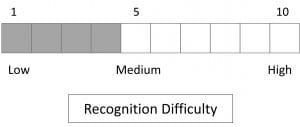 How easy is it to see and recognise something that looks technically inappropriate?
How easy is it to see and recognise something that looks technically inappropriate?
I know from experience it’s tough to do this when you first start coaching. Ok, you can see some things that don’t look right but often they are the ‘bigger’ technical issues. Those where players prepare in a different or strange way to what you expect. Body or racket preparations taken up early are easier to see.
I struggled with the small, subtle issues that often happened within a stroke or movement or happened at speed. I quickly realised that not everything in coaching badminton was easy to see!
Defining technical future limitations
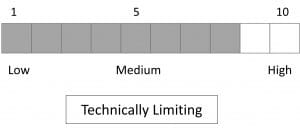 How easy is it to know how technically limiting it is?
How easy is it to know how technically limiting it is?
Identifying it is one thing, but just because it doesn’t fit your technical model or it looks strange doesn’t explain how impactful it could be to future development.
I’ve found (after being told) that some techniques are far more impactful than others in terms of limiting future development. This also applies to the potential to cause injury.
I will try to help
In the next post, I will look at each of the technical limiting faults and outline some of the points for you to look out for. I’ll also indicate the potential severity of the fault if it’s left unaltered.
Have you heard the story about the 3 coaches sitting behind the courts at an U13 tournament?

Coach 1 : Look at the way that player prepares for their backhand net flick, something just doesn’t look or feel right to me.
Coach 2 : Yes I agree. If it’s really a problem we should see the flicks going flat (not high), often crosscourt, and even into the net. However, the player may still play an ok net shot.
Coach 3 : Which court and which player are you looking at? What would this backhand flick technique look like? Can you show me?
– – – – – – – – – – – – – – – –
5. What’s next
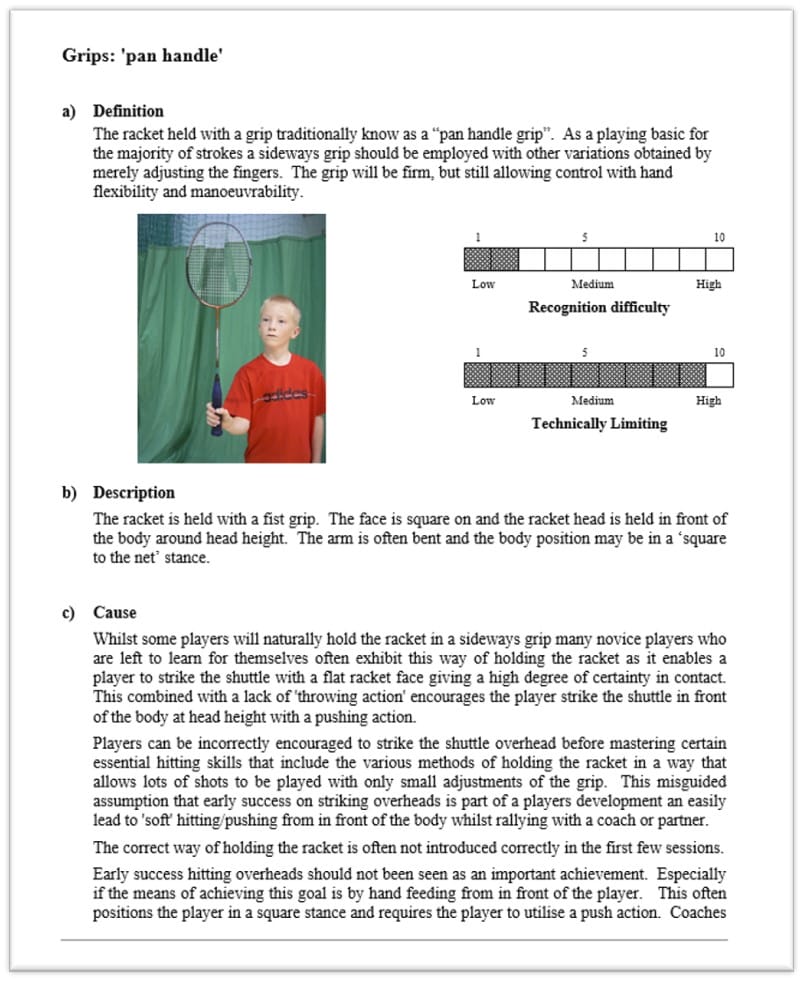 I’ve challenged myself to create a series of posts each concerned with one of Type 2 or 3 errors (Subtle and Critical)
I’ve challenged myself to create a series of posts each concerned with one of Type 2 or 3 errors (Subtle and Critical)
The theme of each post will continue to be ‘Error Prevention rather than Error Correction’, however, I will try my best to explore these points:
- what the issue looks like and the different names it’s called
- why I think the issue occurs
- how to correct it
- how to prevent it from ever appearing
If you’d like to share your list with me that would be great.
Or, maybe you’ve read something about badminton technique errors that you disagree with.
I promise to share all the great advice I’ve been given plus the mistakes I’ve made.
– – – – – – – – – – – – – – – –
Your Challenge
 Could you write down a list of the technical things that players do on the court that you believe constrain or limit, even prevent future development in a young badminton player? You’ve been reading about the badminton technique errors that you see in novice players.
Could you write down a list of the technical things that players do on the court that you believe constrain or limit, even prevent future development in a young badminton player? You’ve been reading about the badminton technique errors that you see in novice players.
Do you have some in mind right now? Grab a pen and make a quick note before you forget 😉
Try and create a list of classic technique errors that you see but wished did not appear in novice players. Those that have the possibility to limit future development of power, variation, and may even cause injury.
What are your top 5 Critical badminton technique errors/ issues in novice players?
If you’d like to share your list with me that would be great. Or, maybe you’d prefer to ask some questions before starting.
Why don’t send me an email it would be great to hear your views contact@badmintonandy.com
